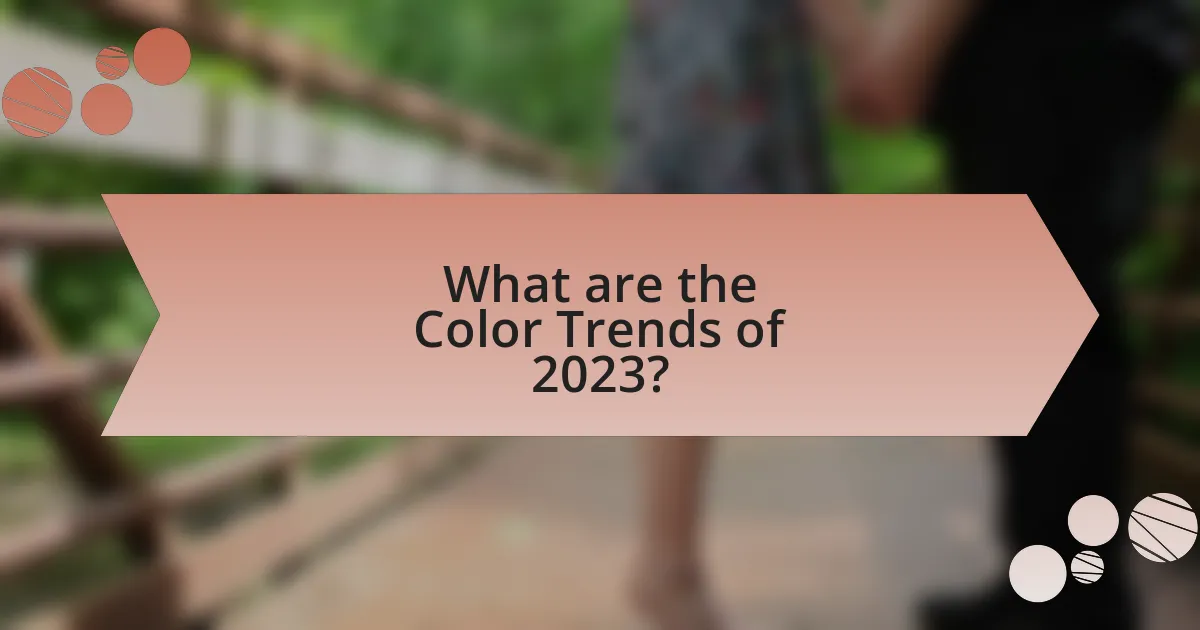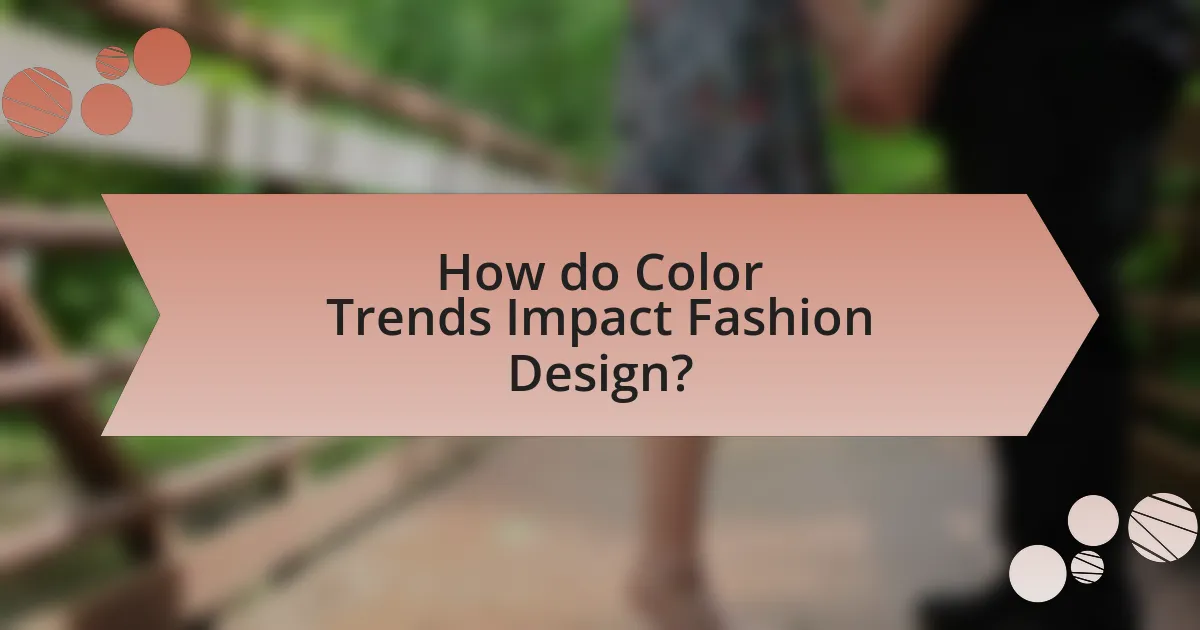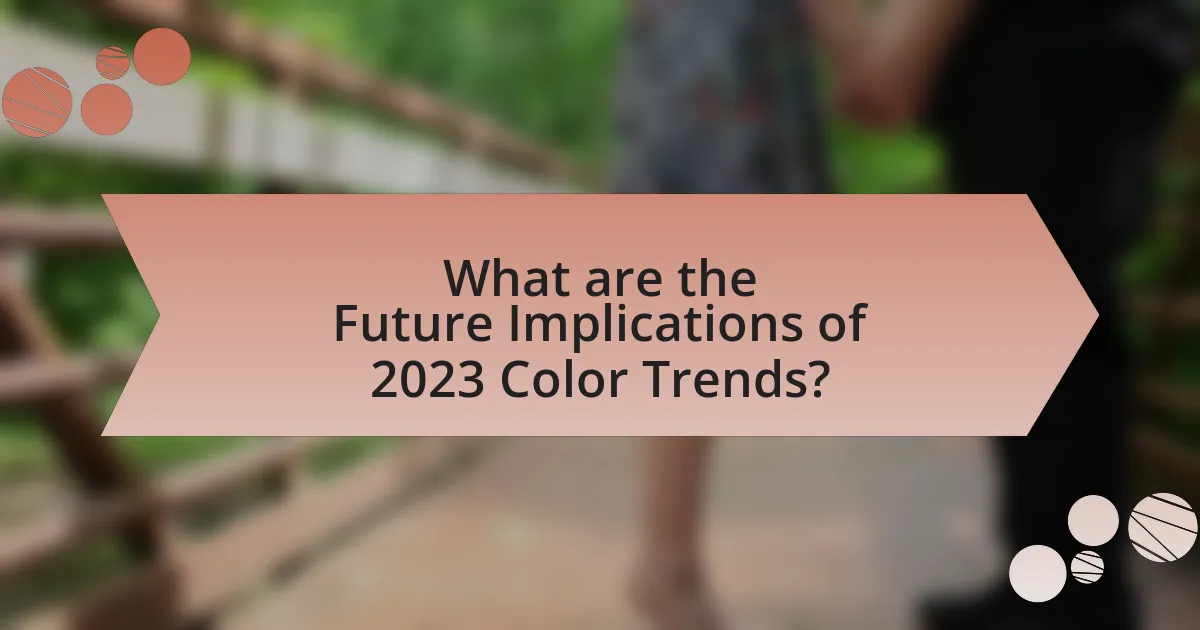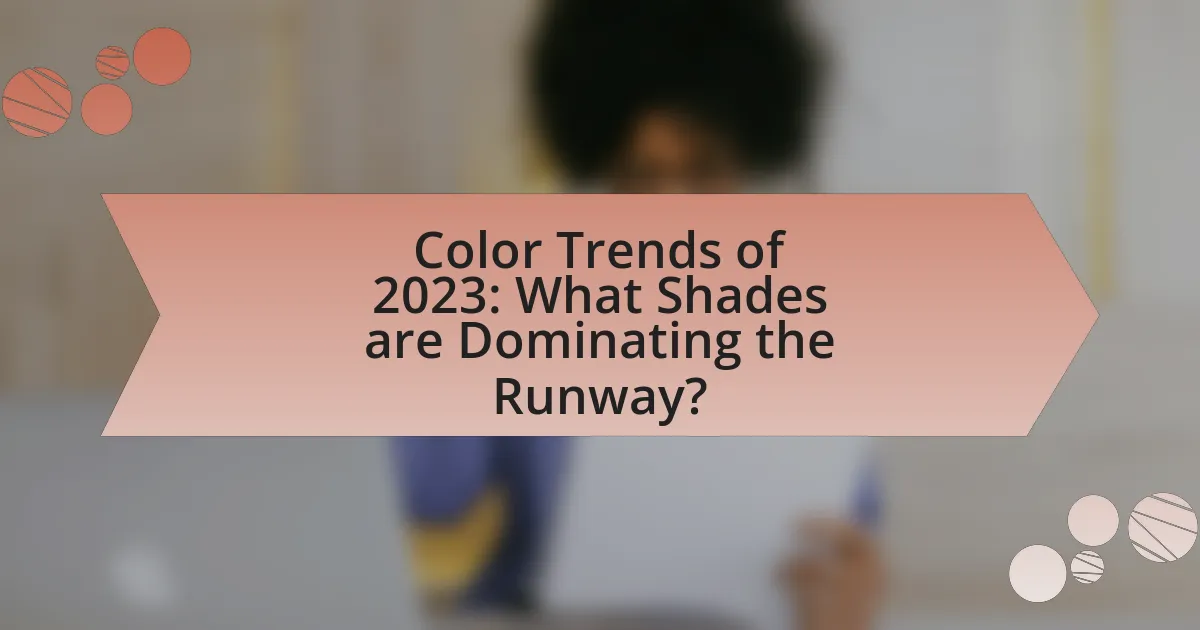The article focuses on the color trends of 2023, highlighting key shades such as Viva Magenta, earthy tones like terracotta and olive green, and vibrant greens and blues that dominate the runway. It explains how color trends are determined in the fashion industry through cultural influences, consumer behavior analysis, and forecasting by trend agencies. The role of fashion weeks in setting these trends is emphasized, along with the psychological effects of color on consumer behavior and purchasing decisions. Additionally, the article discusses the future implications of these trends, particularly in relation to sustainability and emotional resonance in design.

What are the Color Trends of 2023?
The color trends of 2023 prominently feature vibrant shades such as Viva Magenta, a bold red hue recognized as Pantone’s Color of the Year, alongside earthy tones like terracotta and olive green. These colors reflect a shift towards emotional expression and connection to nature, as seen in various fashion collections and design showcases throughout the year. The emphasis on these shades is supported by their frequent appearance in major fashion events, indicating a collective movement towards colors that evoke warmth and vitality.
How are color trends determined in the fashion industry?
Color trends in the fashion industry are determined through a combination of cultural influences, consumer behavior analysis, and forecasting by trend agencies. Cultural influences include societal events, art movements, and technological advancements that shape public perception and preferences. Consumer behavior analysis involves studying purchasing patterns and preferences to identify emerging colors that resonate with target demographics. Trend agencies, such as Pantone and WGSN, conduct extensive research and surveys to predict color trends, often releasing annual reports that highlight key shades expected to dominate the market. For example, Pantone’s Color of the Year has historically influenced fashion collections and consumer choices, showcasing the impact of expert forecasting on color trends.
What role do fashion weeks play in setting color trends?
Fashion weeks play a crucial role in setting color trends by showcasing designers’ collections that highlight specific color palettes for upcoming seasons. These events serve as influential platforms where industry leaders, including designers, buyers, and media, converge to observe and promote the latest styles and colors. For instance, the Pantone Color Institute often analyzes the predominant colors presented during major fashion weeks, such as New York and Paris, to forecast trends. In 2023, colors like vibrant greens and soft pastels emerged as key trends, reflecting the collective vision of designers and the cultural zeitgeist. This cyclical process of presentation and analysis solidifies fashion weeks as pivotal in shaping consumer preferences and retail offerings.
How do cultural influences shape color trends?
Cultural influences shape color trends by reflecting societal values, historical events, and collective emotions. For instance, the resurgence of earthy tones in 2023 can be linked to a growing emphasis on sustainability and connection to nature, driven by environmental movements. Additionally, colors associated with specific cultural celebrations, such as vibrant reds and golds during Lunar New Year, often gain prominence in fashion during those periods. Historical events, like the global pandemic, have also influenced color trends, leading to a preference for calming hues like soft blues and greens as a response to collective anxiety. These examples illustrate how cultural contexts directly impact the popularity and selection of colors in fashion.
What are the key colors dominating the runway in 2023?
The key colors dominating the runway in 2023 are vibrant shades of green, bold blues, and warm earth tones. These colors reflect a shift towards nature-inspired palettes, with green symbolizing renewal and vitality, while bold blues evoke a sense of calm and stability. Earth tones, including terracotta and ochre, connect fashion to organic elements, aligning with sustainability trends in the industry. This color trend is supported by major fashion weeks, where designers showcased collections prominently featuring these hues, indicating their influence on contemporary fashion.
Which shades are considered the “it” colors this year?
The “it” colors for 2023 include vibrant shades such as Digital Lavender, a soft purple that symbolizes tranquility, and Luscious Red, a bold hue representing passion and energy. These colors have been highlighted by color forecasting organizations like Pantone, which emphasizes their relevance in fashion and design this year. Additionally, shades like Verdant Green and Soft Blue are also trending, reflecting a desire for connection to nature and calmness in a post-pandemic world.
How do these colors reflect current societal moods and themes?
Colors in 2023, such as vibrant greens and soft pastels, reflect a societal mood focused on renewal and optimism. The prevalence of green symbolizes a collective desire for sustainability and connection to nature, aligning with global environmental movements. Pastel shades evoke calmness and comfort, resonating with a society seeking solace amid ongoing challenges like economic uncertainty and social unrest. These color choices on the runway mirror broader themes of hope and resilience, as seen in fashion collections that emphasize well-being and positivity, reinforcing the emotional landscape of contemporary life.

How do Color Trends Impact Fashion Design?
Color trends significantly influence fashion design by dictating the palette that designers use in their collections. Designers often analyze color forecasts from industry leaders like Pantone, which reported that colors such as Viva Magenta are trending in 2023, reflecting societal moods and cultural shifts. This alignment with color trends allows designers to create garments that resonate with current consumer preferences, enhancing marketability and relevance. For instance, the use of bold colors can evoke emotions and attract attention, while softer hues may convey calmness and sophistication, directly impacting consumer purchasing decisions.
What is the relationship between color and fashion aesthetics?
The relationship between color and fashion aesthetics is fundamental, as color significantly influences the perception and emotional response to fashion. Colors evoke specific feelings and associations, which designers leverage to create desired aesthetics in their collections. For instance, studies show that warm colors like red and orange can evoke excitement and energy, while cool colors like blue and green often convey calmness and serenity. In 2023, color trends on the runway reflect these principles, with designers using vibrant hues to capture attention and softer tones to create a sense of tranquility, demonstrating how color choices directly shape the overall aesthetic experience in fashion.
How do designers incorporate trending colors into their collections?
Designers incorporate trending colors into their collections by analyzing color forecasts from industry experts and integrating these hues into their designs. For instance, Pantone, a leading color authority, releases a Color of the Year and seasonal palettes that influence designers’ choices. In 2023, shades like Viva Magenta and earthy tones have been highlighted, prompting designers to use these colors in fabrics, patterns, and accessories. This alignment with trending colors not only reflects current consumer preferences but also enhances the marketability of their collections, as seen in major fashion weeks where these colors dominate the runway.
What are the psychological effects of color in fashion?
The psychological effects of color in fashion significantly influence consumer behavior and emotional responses. Colors evoke specific feelings; for instance, red can stimulate excitement and passion, while blue often promotes calmness and trust. Research indicates that 85% of consumers make purchasing decisions based on color alone, highlighting its importance in fashion marketing. Additionally, colors can affect perceptions of body image and self-esteem, with studies showing that wearing certain colors can enhance confidence and attractiveness. Thus, understanding the psychological impact of color is crucial for fashion designers and marketers aiming to connect with their audience effectively.
How do color trends influence consumer behavior?
Color trends significantly influence consumer behavior by shaping perceptions and emotional responses to products. For instance, research indicates that colors can evoke specific feelings; blue often conveys trust and reliability, while red can stimulate excitement and urgency. A study by the Institute for Color Research found that up to 90% of snap judgments about products can be based on color alone, highlighting its critical role in consumer decision-making. Additionally, brands that align their color schemes with current trends can enhance brand recognition and appeal, leading to increased sales and customer loyalty.
What impact do color trends have on purchasing decisions?
Color trends significantly influence purchasing decisions by affecting consumer emotions and perceptions. Research indicates that colors can evoke specific feelings; for instance, blue often conveys trust and reliability, while red can stimulate excitement and urgency. A study by the Institute for Color Research found that up to 90% of snap judgments made about products can be based on color alone. This demonstrates that consumers are more likely to purchase items that align with their emotional responses to color trends, which are often shaped by cultural and seasonal influences. Thus, brands that effectively leverage current color trends can enhance their appeal and drive sales.
How do brands adapt to changing color trends to attract customers?
Brands adapt to changing color trends by conducting market research to identify emerging preferences and incorporating these colors into their product lines. For instance, brands analyze fashion shows, social media, and consumer behavior to forecast which colors will resonate with their target audience. In 2023, shades like vibrant greens and soft pastels have gained popularity, prompting brands to feature these colors prominently in their collections. This strategic alignment with current trends not only enhances brand relevance but also increases customer engagement and sales, as consumers are more likely to purchase products that reflect their aesthetic preferences.

What are the Future Implications of 2023 Color Trends?
The future implications of 2023 color trends indicate a shift towards sustainability and emotional resonance in design. As consumers increasingly prioritize eco-friendly practices, colors that evoke nature, such as earthy tones and soft pastels, are likely to dominate future palettes. This trend aligns with a growing awareness of environmental issues, as evidenced by the rise in popularity of brands that emphasize sustainable materials and production methods. Additionally, the emotional impact of colors, such as calming blues and vibrant yellows, suggests that future designs will focus on enhancing well-being and mental health, reflecting societal needs for comfort and positivity in uncertain times.
How might the color trends of 2023 evolve in the coming years?
The color trends of 2023 are likely to evolve towards more muted and earthy tones as consumers increasingly seek comfort and sustainability in their choices. This shift is supported by a growing preference for natural aesthetics, which has been observed in various fashion and design sectors, indicating a move away from the vibrant and bold colors that characterized previous years. Historical data from color forecasting agencies, such as Pantone, shows that trends often cycle every few years, suggesting that the current inclination towards softer palettes may continue to gain traction as societal values shift towards environmental consciousness and minimalism.
What emerging colors are predicted to rise in popularity?
Emerging colors predicted to rise in popularity include vibrant shades like digital lavender, a soft yet striking hue, and earthy tones such as terracotta and olive green. These colors reflect a shift towards a blend of digital influences and natural aesthetics, aligning with current consumer preferences for both comfort and innovation. The rise of digital lavender, for instance, has been noted in fashion forecasts by Pantone, which emphasizes its calming yet modern appeal. Similarly, the resurgence of earthy tones is supported by trends in sustainable fashion, where natural colors resonate with eco-conscious consumers.
How do sustainability and eco-consciousness affect future color trends?
Sustainability and eco-consciousness significantly influence future color trends by promoting a preference for natural, earthy tones and recycled materials. As consumers increasingly prioritize environmental responsibility, designers are responding by incorporating colors that reflect organic elements, such as greens, browns, and muted shades, which evoke a sense of connection to nature. This shift is supported by market research indicating that 66% of global consumers are willing to pay more for sustainable brands, highlighting the demand for eco-friendly practices in fashion. Consequently, color palettes are evolving to align with these values, emphasizing hues that symbolize sustainability and environmental awareness.
What practical tips can designers and consumers use regarding color trends?
Designers and consumers can effectively utilize color trends by staying informed about current palettes and incorporating them into their work and purchases. Designers should analyze seasonal color reports from organizations like Pantone, which provides insights into trending colors based on cultural and societal influences. Consumers can enhance their wardrobe or home decor by selecting items that reflect these trending colors, ensuring their choices align with contemporary aesthetics. For instance, the Pantone Color Institute’s 2023 Color of the Year, Viva Magenta, emphasizes boldness and vibrancy, encouraging both designers and consumers to embrace this shade in their creations and selections.
How can individuals incorporate trending colors into their wardrobe effectively?
Individuals can effectively incorporate trending colors into their wardrobe by selecting key pieces in those shades and pairing them with neutral tones. For instance, if a vibrant color like electric blue is trending, individuals can invest in a statement jacket or accessory in that color while wearing classic black or white clothing to balance the look. This method allows for the integration of bold colors without overwhelming the overall outfit. Additionally, using color swatches or palettes from fashion resources can help individuals identify which trending colors complement their skin tone and personal style, ensuring a cohesive and fashionable appearance.
What are some best practices for designers when selecting colors for their collections?
Designers should prioritize color harmony, emotional impact, and market trends when selecting colors for their collections. Color harmony ensures that the chosen colors work well together, creating a cohesive look that appeals to consumers. Emotional impact is crucial, as colors evoke specific feelings; for instance, blue often conveys trust, while red can signify passion. Additionally, staying informed about current market trends, such as the rise of earthy tones in 2023, helps designers align their collections with consumer preferences. Research indicates that collections reflecting popular color trends can lead to increased sales and consumer engagement, validating the importance of these best practices.
